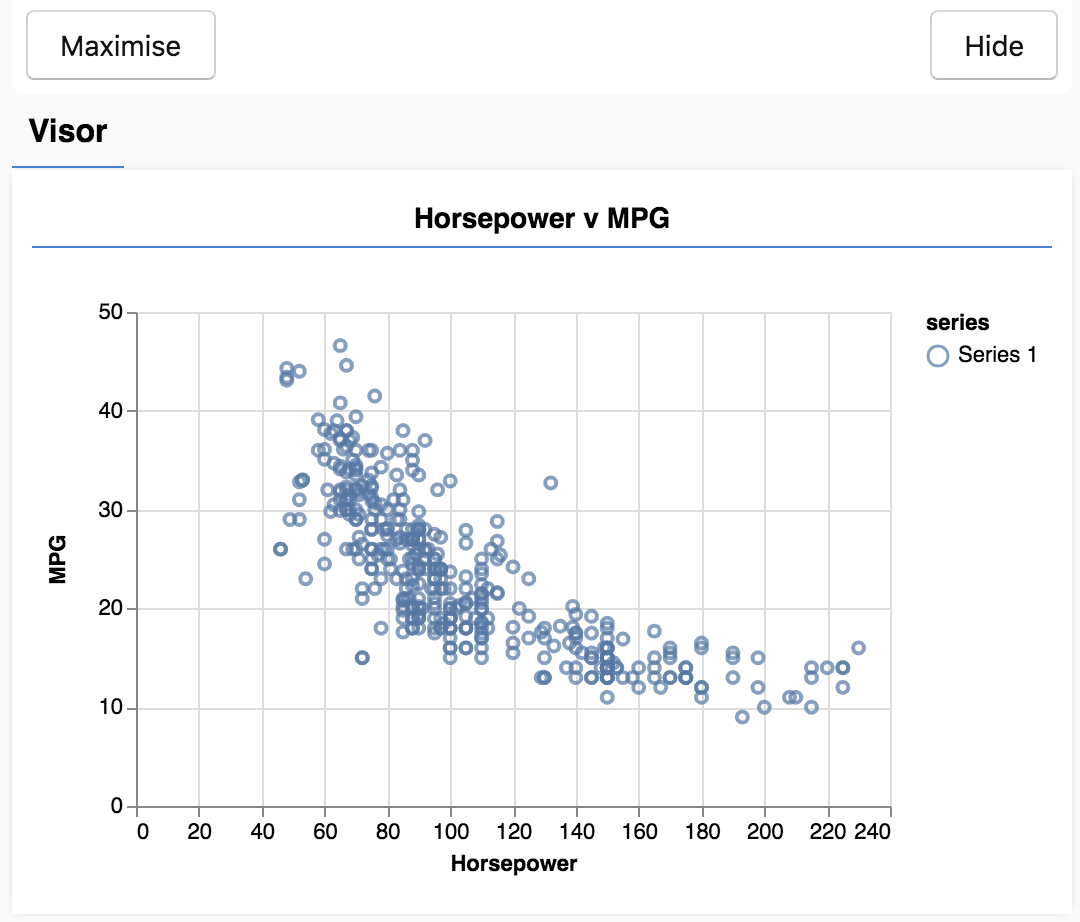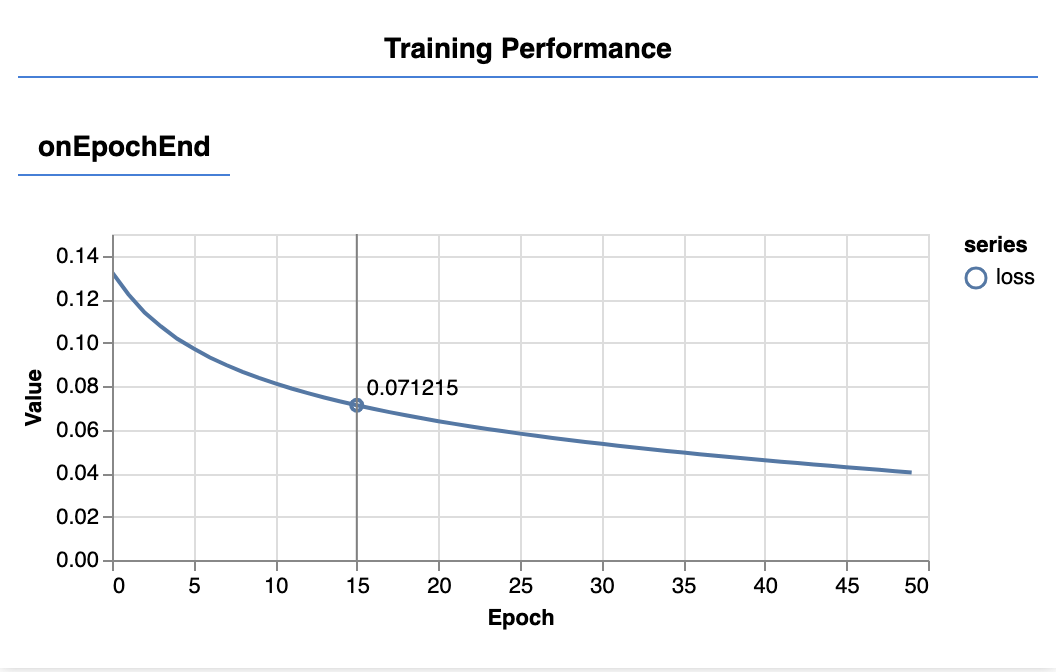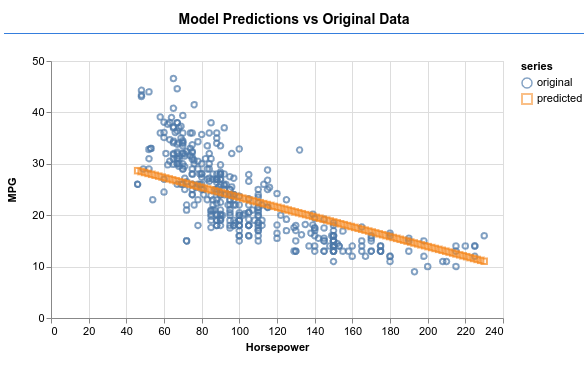1. 簡介
在本程式碼研究室中,您將訓練模型,根據描述一組車輛的數字資料進行預測。
本練習將示範訓練多種不同模型時常用的步驟,但會使用小型資料集和簡易 (淺層) 模型。主要目標在於協助您熟悉 TensorFlow.js 訓練模型的基本術語、概念和語法,並提供有關進一步探索和學習的踏板。
由於我們訓練模型來預測連續數字,因此這項工作有時也稱為「迴歸」工作。為了訓練模型,我們會提供許多輸入內容範例和正確輸出內容。這項功能稱為「監督式學習」。
建構目標
您將建立一個使用 TensorFlow.js 在瀏覽器中訓練模型的網頁。有「馬力」模型會學習預測「每加侖英里數」。
如要這麼做,您需要:
- 載入資料並準備用於訓練。
- 定義模型的架構。
- 訓練模型並在訓練期間監控成效。
- 進行預測以評估訓練過的模型。
課程內容
- 為機器學習準備資料的最佳做法,包括重組和正規化。
- 使用 tf.layers API 建立模型的 TensorFlow.js 語法。
- 如何使用 tfjs-vis 程式庫監控瀏覽器內訓練。
軟硬體需求
- 使用最新版本的 Chrome 或其他新版瀏覽器。
- 文字編輯器,可在您的電腦本機或透過 Codepen 或 Glitch 等網路執行。
- 具備 HTML、CSS、JavaScript 和 Chrome 開發人員工具 (或您偏好的瀏覽器開發人員工具) 的知識。
- 大致瞭解類神經網路的概念。如需相關簡介或複習,請觀看這部 3blue1brown 前的影片,或是這部 Ashi Krishnan 推出的「Deep Learning in JavaScript」影片。
2. 做好準備
建立 HTML 網頁並加入 JavaScript
 將下列程式碼複製到名為 的 HTML 檔案中
將下列程式碼複製到名為 的 HTML 檔案中
index.html
<!DOCTYPE html>
<html>
<head>
<title>TensorFlow.js Tutorial</title>
<!-- Import TensorFlow.js -->
<script src="https://cdn.jsdelivr.net/npm/@tensorflow/tfjs@2.0.0/dist/tf.min.js"></script>
<!-- Import tfjs-vis -->
<script src="https://cdn.jsdelivr.net/npm/@tensorflow/tfjs-vis@1.0.2/dist/tfjs-vis.umd.min.js"></script>
</head>
<body>
<!-- Import the main script file -->
<script src="script.js"></script>
</body>
</html>
建立程式碼的 JavaScript 檔案
- 在與上述 HTML 檔案相同的資料夾中,建立名為 script.js 的檔案,然後將下列程式碼加入其中。
console.log('Hello TensorFlow');
測試
HTML 和 JavaScript 檔案建立完畢後,請測試這些檔案。在瀏覽器中開啟 index.html 檔案,然後開啟開發人員工具控制台。
如果一切正常,開發人員工具控制台中應該會顯示兩個全域變數:
tf是 TensorFlow.js 程式庫的參照tfvis是 tfjs-vis 程式庫的參照
開啟瀏覽器的開發人員工具,控制台輸出內容中應該會顯示 Hello TensorFlow 訊息。如果有的話,就可以進行下一個步驟。
3. 載入輸入資料、設定格式並以視覺化方式呈現輸入資料
首先,我們要載入訓練模型,設定格式並以視覺化方式呈現訓練模型的資料。
我們將載入「cars」資料集它包含每輛車的許多不同功能。針對本教學課程,我們只想擷取馬力和每加侖的英里數資料。
 將下列程式碼加入您的
將下列程式碼加入您的
script.js 檔案
/**
* Get the car data reduced to just the variables we are interested
* and cleaned of missing data.
*/
async function getData() {
const carsDataResponse = await fetch('https://storage.googleapis.com/tfjs-tutorials/carsData.json');
const carsData = await carsDataResponse.json();
const cleaned = carsData.map(car => ({
mpg: car.Miles_per_Gallon,
horsepower: car.Horsepower,
}))
.filter(car => (car.mpg != null && car.horsepower != null));
return cleaned;
}
這樣也會一併移除任何未定義每加侖或馬力值的項目。我們還要用散佈圖繪製這項資料,以便瞭解資料的樣子
 請將以下程式碼加到您的
請將以下程式碼加到您的
script.js 檔案。
async function run() {
// Load and plot the original input data that we are going to train on.
const data = await getData();
const values = data.map(d => ({
x: d.horsepower,
y: d.mpg,
}));
tfvis.render.scatterplot(
{name: 'Horsepower v MPG'},
{values},
{
xLabel: 'Horsepower',
yLabel: 'MPG',
height: 300
}
);
// More code will be added below
}
document.addEventListener('DOMContentLoaded', run);
重新整理頁面時。您應該會在頁面左側看到一個含有資料的散佈圖的面板。看起來應該會像這樣

這個面板稱為 visor,由 tfjs-vis 提供。這個工具可讓您輕鬆顯示視覺化內容。
一般來說,處理資料時,建議您設法查看資料,並視需要加以清除。在此情況下,我們必須從 carsData 中移除缺少所有必填欄位的項目。將資料以視覺化的方式呈現,可讓模型瞭解資料是否有任何結構。
從上圖可看出,馬力與 MPG 之間呈現負相關,例如馬力越強,車輛每加侖的里程數通常較少。
瞭解我們的工作
輸入資料現在看起來會像這樣。
...
{
"mpg":15,
"horsepower":165,
},
{
"mpg":18,
"horsepower":150,
},
{
"mpg":16,
"horsepower":150,
},
...
我們的目標是訓練一個會使用「一個數字」和「馬力」為模型的模型,並學習如何預測「每加侖英里數」這個數字。請記得,一對一對應,這對下一個部分來說至關重要。
我們將將這些範例 (馬力和 MPG) 提供給類神經網路,從這些範例中學習這個公式 (或函數) 來預測 MPG 提供的馬力。我們從具有正確答案的例子中學習稱為監督式學習。
4. 定義模型架構
在本節中,我們將撰寫程式碼來說明模型架構。模型架構是一種精緻做法,可說明「模型在執行時會執行的函式」,或「Google 模型會使用哪些演算法計算答案」。
機器學習模型是會接收輸入內容並產生輸出內容的演算法。使用類神經網路時,演算法是一組具有「權重」的神經元層(數字) 控管其輸出內容。訓練程序將學習這些權重的理想值。
 將下列函式加入
將下列函式加入
script.js 檔案來定義模型架構。
function createModel() {
// Create a sequential model
const model = tf.sequential();
// Add a single input layer
model.add(tf.layers.dense({inputShape: [1], units: 1, useBias: true}));
// Add an output layer
model.add(tf.layers.dense({units: 1, useBias: true}));
return model;
}
這是我們在 tensorflow.js 中能定義的最簡單模型之一,我們稍後會逐一詳細介紹。
將模型執行個體化
const model = tf.sequential();
這會將 tf.Model 物件執行個體化。這個模型的輸入內容直接向下流向輸出,因此是 sequential。其他類型的模型可以包含分支版本,甚至是多個輸入和輸出內容,但在多數情況下,模型會依序處理。依序模型較容易使用 API。
新增圖層
model.add(tf.layers.dense({inputShape: [1], units: 1, useBias: true}));
這樣會在網路中新增輸入層,這個圖層會自動連接至含有一個隱藏單元的 dense 層。dense 圖層是一種圖層,可以將輸入內容乘以矩陣 (稱為「權重」),然後在結果中加入數字 (稱為「偏誤」)。由於這是網路的第一層,我們必須定義 inputShape。inputShape 為 [1],因為我們輸入的數值是 1 (特定車輛的馬力)。
units 可設定圖層的權重矩陣大小。將此值設為 1,即表示資料的每個輸入特徵都會有 1 個權重。
model.add(tf.layers.dense({units: 1}));
上述程式碼會建立輸出層。我們已將 units 設為 1,因為我們要輸出 1 號碼。
建立執行個體
 將下列程式碼加到
將下列程式碼加到
run 函式。
// Create the model
const model = createModel();
tfvis.show.modelSummary({name: 'Model Summary'}, model);
這將建立模型的執行個體,並在網頁上顯示各圖層的摘要。
5. 準備用於訓練的資料
為了讓 TensorFlow.js 能發揮實際效能,訓練機器學習模型時,我們必須將資料轉換為「張量」。我們還會針對資料執行多項轉換,包括重組和正規化。
 將下列程式碼加入您的
將下列程式碼加入您的
script.js 檔案
/**
* Convert the input data to tensors that we can use for machine
* learning. We will also do the important best practices of _shuffling_
* the data and _normalizing_ the data
* MPG on the y-axis.
*/
function convertToTensor(data) {
// Wrapping these calculations in a tidy will dispose any
// intermediate tensors.
return tf.tidy(() => {
// Step 1. Shuffle the data
tf.util.shuffle(data);
// Step 2. Convert data to Tensor
const inputs = data.map(d => d.horsepower)
const labels = data.map(d => d.mpg);
const inputTensor = tf.tensor2d(inputs, [inputs.length, 1]);
const labelTensor = tf.tensor2d(labels, [labels.length, 1]);
//Step 3. Normalize the data to the range 0 - 1 using min-max scaling
const inputMax = inputTensor.max();
const inputMin = inputTensor.min();
const labelMax = labelTensor.max();
const labelMin = labelTensor.min();
const normalizedInputs = inputTensor.sub(inputMin).div(inputMax.sub(inputMin));
const normalizedLabels = labelTensor.sub(labelMin).div(labelMax.sub(labelMin));
return {
inputs: normalizedInputs,
labels: normalizedLabels,
// Return the min/max bounds so we can use them later.
inputMax,
inputMin,
labelMax,
labelMin,
}
});
}
現在就來詳細說明
重組資料
// Step 1. Shuffle the data
tf.util.shuffle(data);
我們在此處隨機排列提供給訓練演算法的範例順序。重組十分重要,因為在訓練期間,系統會將用來訓練模型的資料集細分為較小的子集 (稱為「批次」)。隨機排序可協助每個批次的資料分佈情形中提供多種資料。這麼做可協助模型:
- 無法學習完全依賴資料動態饋給的順序
- 不必區分子群組中的結構 (例如,如果模型的前半段只看到高馬力汽車,就可能學習關係,不適用於其他資料集)。
轉換為張量
// Step 2. Convert data to Tensor
const inputs = data.map(d => d.horsepower)
const labels = data.map(d => d.mpg);
const inputTensor = tf.tensor2d(inputs, [inputs.length, 1]);
const labelTensor = tf.tensor2d(labels, [labels.length, 1]);
我們製作兩個陣列,一個用於輸入範例 (馬力項目),另一個代表真實輸出值 (在機器學習中稱為標籤)。
接著將每個陣列資料轉換為 2d 張量。張量的形狀會是 [num_examples, num_features_per_example]。以下提供 inputs.length 範例,每個範例都具備 1 輸入特徵 (馬力)。
將資料正規化
//Step 3. Normalize the data to the range 0 - 1 using min-max scaling
const inputMax = inputTensor.max();
const inputMin = inputTensor.min();
const labelMax = labelTensor.max();
const labelMin = labelTensor.min();
const normalizedInputs = inputTensor.sub(inputMin).div(inputMax.sub(inputMin));
const normalizedLabels = labelTensor.sub(labelMin).div(labelMax.sub(labelMin));
接下來,我們要做另一項機器學習訓練最佳做法。我們會將資料正規化。在此,我們會使用最小值到最大縮放功能,將資料正規化為數值範圍 0-1。正規化十分重要,因為透過 tensorflow.js 建構的許多機器學習模型,其內部都是專為處理過小的數字而設計。將資料正規化後,納入 0 to 1 或 -1 to 1 的常見範圍。如果讓資料習慣在合理範圍內進行正規化,您將更能成功訓練模型。
傳回資料和正規化邊界
return {
inputs: normalizedInputs,
labels: normalizedLabels,
// Return the min/max bounds so we can use them later.
inputMax,
inputMin,
labelMax,
labelMin,
}
我們希望保留訓練期間用於正規化的值,以便不正規化輸出資料,回到原本的量表,並讓我們以同樣的方式將未來的輸入資料正規化。
6. 訓練模型
建立模型執行個體並以「張量」表示資料後,我們就有一切準備開始訓練程序。
 將下列函式複製到
將下列函式複製到
script.js 檔案。
async function trainModel(model, inputs, labels) {
// Prepare the model for training.
model.compile({
optimizer: tf.train.adam(),
loss: tf.losses.meanSquaredError,
metrics: ['mse'],
});
const batchSize = 32;
const epochs = 50;
return await model.fit(inputs, labels, {
batchSize,
epochs,
shuffle: true,
callbacks: tfvis.show.fitCallbacks(
{ name: 'Training Performance' },
['loss', 'mse'],
{ height: 200, callbacks: ['onEpochEnd'] }
)
});
}
來詳細說明
為訓練做好準備
// Prepare the model for training.
model.compile({
optimizer: tf.train.adam(),
loss: tf.losses.meanSquaredError,
metrics: ['mse'],
});
我們必須「編譯」先訓練模型為此,我們必須指定一些非常重要的項目:
optimizer:這種演算法會在模型看到樣本時控管其更新。TensorFlow.js 中有許多最佳化器。我們在這裡挑選了 adam 最佳化工具,它在實務上非常有效,而且不需要設定。loss:這個函式將告知模型每個已顯示的批次 (資料子集) 學習成效。這裡,我們使用meanSquaredError,比較模型產生的預測結果與真實值。
const batchSize = 32;
const epochs = 50;
接著要選擇批量和幾個訓練週期:
batchSize是指模型在每次訓練疊代時看到的資料子集大小。常見的批量介於 32 到 512 之間。並非所有問題的批量都適合,但是這不在本教學課程的討論範圍內,我們將解說各種批量的數學動機。epochs是指模型查看您提供的整個資料集的次數。在這個資料集裡,我們會疊代 50 次資料集
啟動火車迴圈
return await model.fit(inputs, labels, {
batchSize,
epochs,
callbacks: tfvis.show.fitCallbacks(
{ name: 'Training Performance' },
['loss', 'mse'],
{ height: 200, callbacks: ['onEpochEnd'] }
)
});
model.fit 是我們會呼叫的函式,用來啟動訓練迴圈。這是非同步函式,因此我們會傳回它提供的承諾,讓呼叫端能判斷訓練完成的時間。
為了監控訓練進度,我們會將一些回呼傳遞至 model.fit。我們使用 tfvis.show.fitCallbacks 產生用於繪製「損失」圖表的函式以及「mse」指標數據
完整的實作範例
現在,我們必須呼叫從 run 函式定義的函式。
 請將以下程式碼加到您的
請將以下程式碼加到您的
run 函式。
// Convert the data to a form we can use for training.
const tensorData = convertToTensor(data);
const {inputs, labels} = tensorData;
// Train the model
await trainModel(model, inputs, labels);
console.log('Done Training');
重新整理頁面後,您應該在幾秒後看到下列圖表正在更新。

這些程式碼是由我們先前建立的回呼所建立。它們會顯示每個週期結束時的全部資料集平均值。
訓練模型時,我們希望可以看到損失下降。本例中的指標是錯誤的指標,因此我們想看到結果也會下降。
7. 進行預測
模型訓練完成之後,接下來想要進行預測,接著我們來評估模型在低至高馬力數範圍內預測的內容。
 在 Script.js 檔案中新增下列函式
在 Script.js 檔案中新增下列函式
function testModel(model, inputData, normalizationData) {
const {inputMax, inputMin, labelMin, labelMax} = normalizationData;
// Generate predictions for a uniform range of numbers between 0 and 1;
// We un-normalize the data by doing the inverse of the min-max scaling
// that we did earlier.
const [xs, preds] = tf.tidy(() => {
const xsNorm = tf.linspace(0, 1, 100);
const predictions = model.predict(xsNorm.reshape([100, 1]));
const unNormXs = xsNorm
.mul(inputMax.sub(inputMin))
.add(inputMin);
const unNormPreds = predictions
.mul(labelMax.sub(labelMin))
.add(labelMin);
// Un-normalize the data
return [unNormXs.dataSync(), unNormPreds.dataSync()];
});
const predictedPoints = Array.from(xs).map((val, i) => {
return {x: val, y: preds[i]}
});
const originalPoints = inputData.map(d => ({
x: d.horsepower, y: d.mpg,
}));
tfvis.render.scatterplot(
{name: 'Model Predictions vs Original Data'},
{values: [originalPoints, predictedPoints], series: ['original', 'predicted']},
{
xLabel: 'Horsepower',
yLabel: 'MPG',
height: 300
}
);
}
使用上述函式時需要留意的幾個事項。
const xsNorm = tf.linspace(0, 1, 100);
const predictions = model.predict(xsNorm.reshape([100, 1]));
我們會產生 100 個新的「範例」傳送給模型Model.predict 是我們將這些範例輸入模型的方式,請注意,這些形狀的形狀必須和我們訓練時一樣 ([num_examples, num_features_per_example])。
// Un-normalize the data
const unNormXs = xsNorm
.mul(inputMax.sub(inputMin))
.add(inputMin);
const unNormPreds = predictions
.mul(labelMax.sub(labelMin))
.add(labelMin);
為了將資料回復到原本的範圍 (而不是 0-1),我們會使用正規化時計算出的值,但只是反轉運算。
return [unNormXs.dataSync(), unNormPreds.dataSync()];
.dataSync() 是可用於取得儲存在張量中之 typedarray 值的方法。這樣我們就能在一般 JavaScript 中處理這些值。這是 .data() 方法的同步版本,通常建議使用。
最後,我們使用 tfjs-vis 繪製原始資料和模型的預測結果。
 將下列程式碼加入您的
將下列程式碼加入您的
run 函式。
// Make some predictions using the model and compare them to the
// original data
testModel(model, data, tensorData);
重新整理頁面後,畫面應會顯示如下的內容。

恭喜!您剛剛訓練了一個簡單的機器學習模型。這項工具目前會執行稱為線性迴歸的運算,試著將線條與輸入資料中呈現的趨勢對齊。
8. 主要重點
訓練機器學習模型的步驟包括:
規劃工作:
- 是迴歸問題還是分類問題?
- 監督式學習或非監督式學習都可以做到這一點嗎?
- 輸入資料的形狀為何?輸出資料應呈現什麼形式?
準備資料:
- 清理資料,可能的話,手動檢查資料是否有模式
- 先重組資料,再用於訓練
- 請將資料正規化為類神經網路的合理範圍。通常 0-1 或 -1-1 是適合數值資料的範圍。
- 將資料轉換為張量
建構並執行模型:
- 使用
tf.sequential或tf.model定義模型,然後使用tf.layers.*新增圖層 - 選擇最佳化工具 ( adam 通常是個好方法),以及批量和訓練週期數等參數。
- 根據問題選擇合適的損失函式,以及評估進度的準確度指標。
meanSquaredError是迴歸問題的常見損失函式。 - 監控訓練,看看損失是否有下降
評估模型
- 選擇您在訓練時可以監控的模型評估指標。訓練完畢後,請嘗試進行一些測試預測,以便瞭解預測品質。
9. 額外課程內容:建議做法
- 實驗變更訓練週期數。您需要多少訓練週期才能平分圖形。
- 嘗試增加隱藏層中的單位數量。
- 嘗試在我們新增的第一個隱藏層和最終輸出層「介於」之間,新增更多隱藏層。這些額外圖層的程式碼應如下所示。
model.add(tf.layers.dense({units: 50, activation: 'sigmoid'}));
對這些隱藏層來說,最重要的新好處是導入非線性活化函式,在本例中為 sigmoid 啟動函式。如要進一步瞭解啟動函式,請參閱這篇文章。
請確認您是否能讓模型產生輸出內容,如下圖所示。


